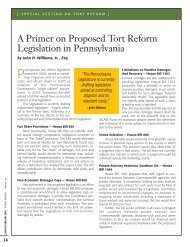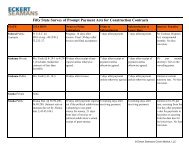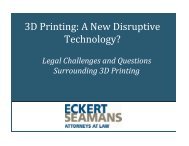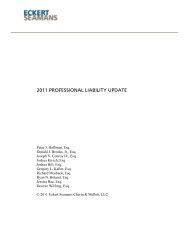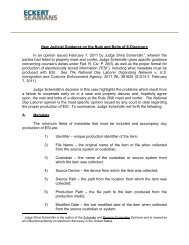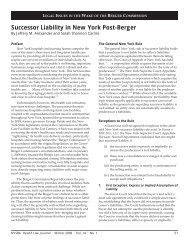Since the 2005 amendments, there have been many reported decisions from Pennsylvaniaappellate courts interpreting and applying the Rules of Civil Procedure that require a plaintiff tofile a certificate of merit in professional negligence cases within sixty days of filing thecomplaint, and that allow for judgment of non pros to be entered if a certificate is not filed.These are summarized below.(b)Failure to Timely File/Substantial Compliance(i)Failure to Timely File/Excuses for DelayIn Womer v. Hilliker, 908 A.2d 269 (Pa. 2006), Plaintiff filed a medical malpracticecomplaint in August of 2003. He did not, however, file a certificate of merit within sixty days offiling the complaint as required under Pa. R. Civ. P 1042.3. He also did not file a motion toextend the time for filing the certificate of merit as permitted under Rule 1042.3(d). Defendantthen filed a Praecipe for Entry of Judgment of Non Pros in accordance with Rule 1042.6 forfailure to file the certificate of merit. Judgment in Defendant’s favor was entered that day. Twodays later Plaintiff filed a motion to open the judgment and to allow the filing of a certificate ofmerit nunc pro tunc. Plaintiff argued, among other things, that he had served an expert report onDefendant in discovery before the deadline for filing the certificate of merit that included all theinformation required to be in a certificate of merit. He contended that the purpose of Rule 1042.3had thus been served. He also attached a certificate of merit to his motion dated one day after thefiling deadline. Plaintiff cited Rule 126 and argued that strict adherence to Rule 1042.3 wouldundermine the Supreme Court’s purpose to eliminate the filing of non-meritorious professionalliability claims.The trial court denied Plaintiff’s motion as well as a subsequent motion forreconsideration. On appeal, the Superior Court found that Plaintiff’s contention that he compliedwith Rule 1042.3 by supplying an expert report was not unreasonable given the lack of case lawon the issue at that time. The Superior Court reversed the trial court order and remanded the casewith instructions that the court vacate the judgment of non pros if there was adequate proof thatPlaintiff had supplied the expert report to Defendant. The Supreme Court then grantedDefendant’s petition for allowance of appeal.The Supreme Court stated that its focus was on whether Rule 1042.3 is subject toequitable exceptions, and noted at the outset of this discussion that the rule as written contains nosuch exceptions. The court then considered whether Rule 126 should play any part in excusingPlaintiff’s failure to file a certificate of merit. The court noted that Rule 126 provides in relevantpart that a court “may disregard error or defect of procedure which does not affect the substantialrights of the parties.” The court explained that while they “look for full compliance with theterms of our rules, we provide a limited exception under Rule 126 to those who commit amisstep when attempting to do what any particular rule requires.”After reviewing previous pertinent cases, the Supreme Court concluded, as the trial courthad done, that Rule 126 should not be considered because plaintiff had not attempted to complywith Rule 1042.3 and made some procedural error, but rather had taken no steps at all to comply112
with the Rule. Pointedly, the court stated that the “equitable doctrine we incorporated into Rule126 is one of substantial compliance, not one of no compliance.” Consequently, the SupremeCourt held that the Superior Court had erred in considering Rule 126 and ordered the trial court’sorder denying Plaintiff’s motion to open the judgment to be reinstated.The court also explained, however, that a plaintiff who fails to file a certificate of merit asrequired is not without any remedy to save his action. Specifically, the court stated that underRule 3051, which allows a trial court to grant relief from a judgment of non pros, a plaintiffmight be able to demonstrate that his failure to follow Rule 1042.3 should be excused. In statingthis, the court noted that some lower court cases, such as Hoover v. Davila, 64 D. & C. 4th 449(Lawrence Co. 2003), aff’d on other grounds, 862 A.2d 591 (Pa. Super. 2004), have incorrectlyheld that a Rule 1042.6 judgment of non pros may not be opened under Rule 3051. TheSupreme Court held to the contrary and explicitly disapproved of Hoover and similar cases.In Sabo v. Worrall, 959 A.2d 347 (Pa. Super. Ct. 2008), the Superior Court examinedwhether Plaintiff had a reasonable excuse for Plaintiff’s failure to timely file certificates of merit.Plaintiff alleged that certificates of merit were prepared within a few days of filing theComplaint, but due to counsel’s oversight were never in fact filed. Counsel for Plaintiff allegedhe believed his paralegal had filed the certificates of merit, but learned the certificates of meritwere not filed when he received notice of the entry of judgment of non pros. The court focusedon Rule 126, to determine whether Plaintiff’s late filing of the certificates of merit wasexcusable.The court distinguished Womer, noting that while Plaintiff’s action was not a proceduralmistake, it certainly was not “a wholesale failure to take any action required by the Rules of CivilProcedure.” The court explained that unlike in Womer, counsel for Plaintiff prepared acertificate of merit, and the failure to file the certificate of merit was “an inadvertent mistake oroversight by counsel’s paralegal.” The court emphasized that, in Womer, counsel for Plaintiff“took it upon himself to conclude that submitting an expert’s report to the opposition‘substantially complied with Rule 1042.3.’”The court reasoned Defendants were not prejudiced by Plaintiff’s untimely filing of acertificate of merit, and the spirit of Rule 1042.3 was not compromised. The court explained, the“filing was not impeded by any intent to substitute an alternative document under the guise ofour Rules of Civil Procedure.” The court further held the inadvertent mistake or oversight bycounsel for Plaintiff in preparing, but forgetting to file the certificates of merit was a reasonableexplanation or legitimate excuse for the delay.At first glance the opinions of Sabo and Womer seem at odds with one another. Thecourts have held obtaining an expert opinion and providing it to opposing counsel will not avoiddismissal for failure to file a certificate of merit; however, obtaining an expert’s report andpreparing certificates of merit which are not sent can avoid dismissal for failure to file acertificate of merit. Based upon the court’s holdings in Sabo and Womer, it appears the courtwill excuse a minor oversight of an attorney who intends on complying precisely with the rule,while the court will not excuse the actions of an attorney who complies with the intent of the113
- Page 3 and 4:
EMTALA CASES ......................
- Page 5:
Filing an Affidavit of Non-Involvem
- Page 8 and 9:
II.PROFESSIONAL LIABILITY - AN OVER
- Page 10 and 11:
The Superior Court reversed the tri
- Page 12 and 13:
to a third party pursuant to the st
- Page 14 and 15:
After approximately five months, De
- Page 16 and 17:
learned the day after the surgery t
- Page 18 and 19:
conduct to the delay in colon cance
- Page 20 and 21:
court admitted the expert’s testi
- Page 22 and 23:
(b)(c)other reasonable causes, incl
- Page 24 and 25:
corroborated his testimony. The cou
- Page 26 and 27:
husband’s estate. Plaintiff alleg
- Page 28 and 29:
Other notable federal cases arising
- Page 30 and 31:
The Superior Court found that in re
- Page 32 and 33:
§ 1303.512(b). The court, however,
- Page 34 and 35:
In Neidig v. United States, No. 07-
- Page 36 and 37:
Additionally, the Supreme Court not
- Page 38 and 39:
were not indicated for her conditio
- Page 40 and 41:
surgeon is the same as it would be
- Page 42 and 43:
It should be noted that the Superio
- Page 44 and 45:
Finally, the court held that the tr
- Page 46 and 47:
The Supreme Court of Pennsylvania r
- Page 48 and 49:
nurses deviating from applicable st
- Page 50 and 51:
certainty, the court reviews expert
- Page 52 and 53:
Under Pennsylvania law, the Court n
- Page 54 and 55:
testimony, Defendant presented his
- Page 56 and 57:
Following Cooper v. Roberts, 286 A.
- Page 58 and 59:
Plaintiff developed chronic diarrhe
- Page 60 and 61:
where payment is made by Medicaid w
- Page 62 and 63:
accomplished. In Valles v. Albert E
- Page 64 and 65:
In 1980, the Pennsylvania Superior
- Page 66 and 67:
Plaintiff had a routine monitoring
- Page 68 and 69: Plaintiff’s Contract ClaimsThe Co
- Page 70 and 71: is a failure to report changes in a
- Page 72 and 73: unit to assure post-surgical patien
- Page 74 and 75: sliced his wrist and arm with a raz
- Page 76 and 77: licensed professionals for whom the
- Page 78 and 79: (c)Limitations of Corporate Neglige
- Page 80 and 81: Even more recently, our Superior Co
- Page 82 and 83: (a)HMO IssuesIn McClellan v. Health
- Page 84 and 85: affidavit submitted by Defendants o
- Page 86 and 87: treatments while at VA’s faciliti
- Page 88 and 89: [s]ubstantively, we believe that a
- Page 90 and 91: The party claiming the benefit of t
- Page 92 and 93: deprive (him) of civil rights guara
- Page 94 and 95: found that the District Court was w
- Page 96 and 97: With respect to fraudulent concealm
- Page 98 and 99: would be applied in situations wher
- Page 100 and 101: they had not raised them in the cou
- Page 102 and 103: (a)Informed ConsentUnder MCARE, a p
- Page 104 and 105: civil enforcement provisions and ma
- Page 106 and 107: MCARE also changes the manner in wh
- Page 108 and 109: whose death, in 2005, was allegedly
- Page 110 and 111: vicariously liable if the plaintiff
- Page 112 and 113: health center or its equivalent or
- Page 114 and 115: In Pennsylvania Medical Society, th
- Page 116 and 117: to any professional who is alleged
- Page 120 and 121: ule, but who intentionally ignores
- Page 122 and 123: the original Complaint was delivere
- Page 124 and 125: foreclose all challenges against th
- Page 126 and 127: number of boxes), which was support
- Page 128 and 129: questions of professional judgment
- Page 130 and 131: deviated from any professional stan
- Page 132 and 133: The Third Circuit affirmed the Dist
- Page 134 and 135: claims and cross-claims remain agai
- Page 136 and 137: By an Amendatory Order dated March
- Page 138 and 139: The court acknowledged that there i
- Page 140 and 141: apply and that the trial court misa
- Page 142 and 143: Barbados had enough litigation-spec
- Page 144 and 145: E. Preemption of Vaccine Design Def
- Page 146 and 147: 2. Pa. R. Civ. Pro. 1036.1 - Reinst
- Page 148 and 149: Barrick, at *34-35.Furthermore, the
- Page 150 and 151: (b) the utility of the defendant’
- Page 152 and 153: 2006). In this case, Plaintiffs bro
- Page 154 and 155: B. Elements of a Cause of Action fo
- Page 156 and 157: decision in Muhammad precluded Mr.
- Page 158 and 159: considered speculative “only if t
- Page 160 and 161: underlying cause of action involved
- Page 162 and 163: In Capital Care Corp., the Superior
- Page 164 and 165: The court found, however, to state
- Page 166 and 167: of reasonable diligence. The standa
- Page 168 and 169:
not be set aside. On July 7, 2005,
- Page 170 and 171:
complete bar to recovery. Since a l
- Page 172 and 173:
On appeal, Plaintiffs claimed that
- Page 174 and 175:
In Liggon-Redding, 659 F.3d at 265,
- Page 176 and 177:
elieved of those minimum standards
- Page 178 and 179:
elevant to the proceedings, the com
- Page 180 and 181:
establish professional misconduct b
- Page 182 and 183:
Upholding the Superior Court’s Or
- Page 184 and 185:
Id.Rejecting revocation and suspens
- Page 186 and 187:
order as a sanction under Rule 4019
- Page 188:
{1009912]182



